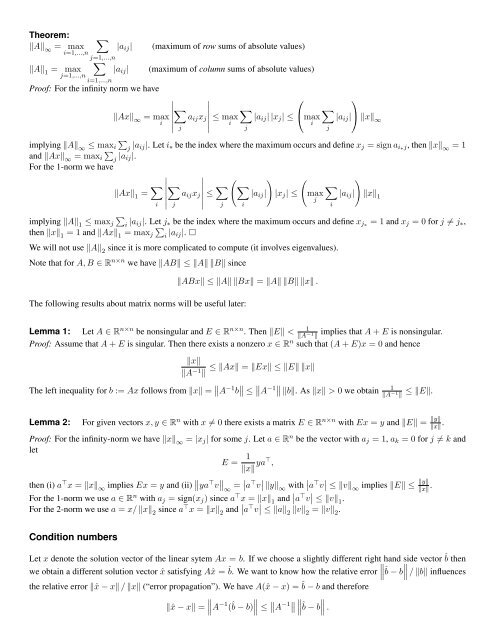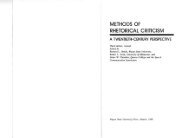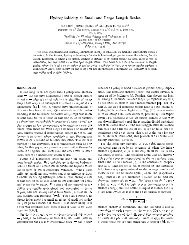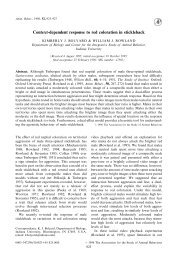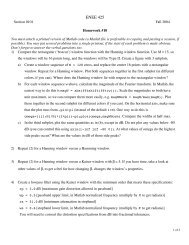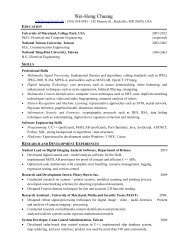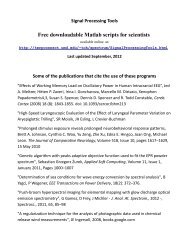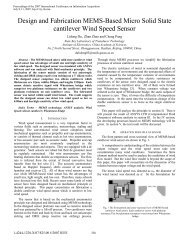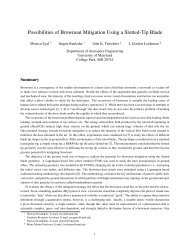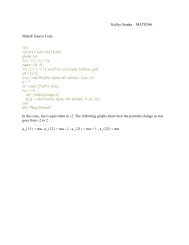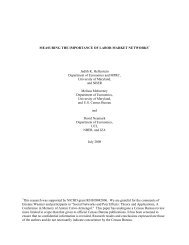Errors for Linear Systems When we solve a - TerpConnect
Errors for Linear Systems When we solve a - TerpConnect
Errors for Linear Systems When we solve a - TerpConnect
You also want an ePaper? Increase the reach of your titles
YUMPU automatically turns print PDFs into web optimized ePapers that Google loves.
Theorem:<br />
A ∞ = max<br />
A 1 = max<br />
<br />
i=1,...,n<br />
j=1,...,n<br />
<br />
j=1,...,n<br />
i=1,...,n<br />
Proof: For the infinity norm <strong>we</strong> have<br />
|aij| (maximum of row sums of absolute values)<br />
|aij| (maximum of column sums of absolute values)<br />
Ax ∞ = max<br />
i<br />
<br />
<br />
<br />
<br />
<br />
<br />
implying A∞ ≤ maxi <br />
and Ax∞ = maxi j |aij|.<br />
For the 1-norm <strong>we</strong> have<br />
Ax1 = <br />
<br />
<br />
<br />
<br />
<br />
<br />
j<br />
aijxj<br />
<br />
⎛<br />
<br />
<br />
<br />
<br />
≤ max |aij| |xj| ≤ ⎝max<br />
i<br />
i<br />
j<br />
j<br />
|aij|<br />
⎞<br />
⎠ x ∞<br />
<br />
j |aij|. Let i∗ be the index where the maximum occurs and define xj = sign ai∗j, then x ∞ = 1<br />
i<br />
j<br />
aijxj<br />
<br />
<br />
<br />
<br />
≤<br />
<br />
j<br />
i<br />
|aij|<br />
<br />
|xj| ≤<br />
<br />
implying A1 ≤ maxj i |aij|. Let j∗ be the index where the maximum occurs and define xj∗ = 1 and xj <br />
= 0 <strong>for</strong> j = j∗,<br />
then x1 = 1 and Ax1 = maxj i |aij|. <br />
<br />
max<br />
j<br />
We will not use A 2 since it is more complicated to compute (it involves eigenvalues).<br />
Note that <strong>for</strong> A, B ∈ R n×n <strong>we</strong> have AB ≤ A B since<br />
The following results about matrix norms will be useful later:<br />
ABx ≤ A Bx = A B x .<br />
Lemma 1: Let A ∈ Rn×n be nonsingular and E ∈ Rn×n . Then E < 1<br />
A−1 implies that A + E is nonsingular.<br />
<br />
Proof: Assume that A + E is singular. Then there exists a nonzero x ∈ Rn such that (A + E)x = 0 and hence<br />
x<br />
A−1 ≤ Ax = Ex ≤ E x<br />
<br />
The left inequality <strong>for</strong> b := Ax follows from x = <br />
A−1b ≤ A−1 1<br />
b. As x > 0 <strong>we</strong> obtain A−1 ≤ E.<br />
<br />
Lemma 2: For given vectors x, y ∈ R n with x = 0 there exists a matrix E ∈ R n×n with Ex = y and E = y<br />
x .<br />
Proof: For the infinity-norm <strong>we</strong> have x ∞ = |xj| <strong>for</strong> some j. Let a ∈ R n be the vector with aj = 1, ak = 0 <strong>for</strong> j = k and<br />
let<br />
E = 1<br />
x ya⊤ ,<br />
then (i) a ⊤ x = x ∞ implies Ex = y and (ii) ya ⊤ v ∞ = a ⊤ v y∞ with a ⊤ v ≤ v∞ implies E ≤ y<br />
x .<br />
For the 1-norm <strong>we</strong> use a ∈ R n with aj = sign(xj) since a ⊤ x = x 1 and a ⊤ v ≤ v1 .<br />
For the 2-norm <strong>we</strong> use a = x/ x 2 since a ⊤ x = x 2 and a ⊤ v ≤ a2 v 2 = v 2 .<br />
Condition numbers<br />
Let x denote the solution vector of the linear sytem Ax = b. If <strong>we</strong> choose a slightly different right hand side vector ˆb then<br />
<strong>we</strong> obtain a different solution vector ˆx satisfying Aˆx = ˆ <br />
<br />
b. We want to know how the relative error ˆ <br />
<br />
b − b<br />
/ b influences<br />
the relative error ˆx − x / x (“error propagation”). We have A(ˆx − x) = ˆb − b and there<strong>for</strong>e<br />
<br />
<br />
ˆx − x = A −1 ( ˆ <br />
<br />
b − b) ≤ −1<br />
A <br />
<br />
ˆ <br />
b − b<br />
.<br />
<br />
i<br />
|aij|<br />
<br />
x 1


